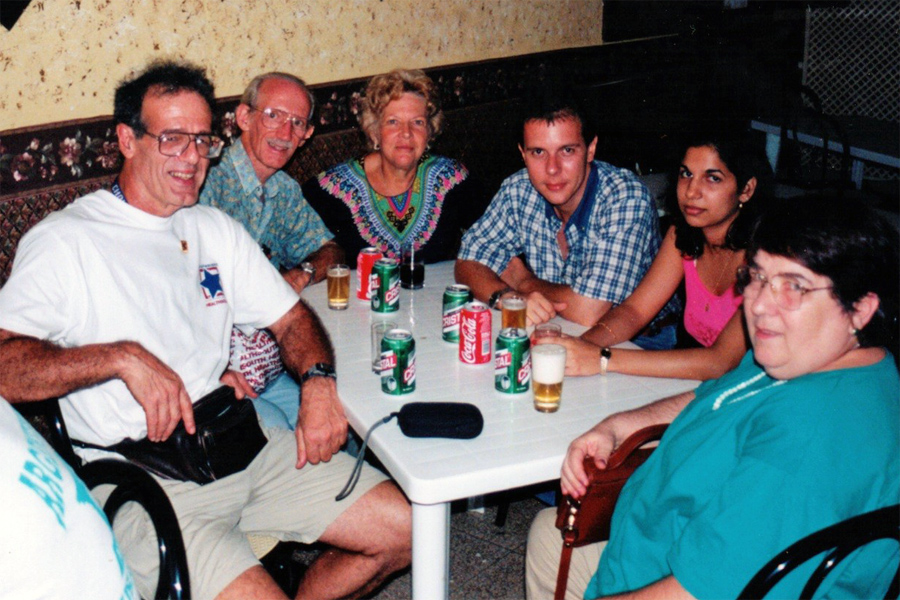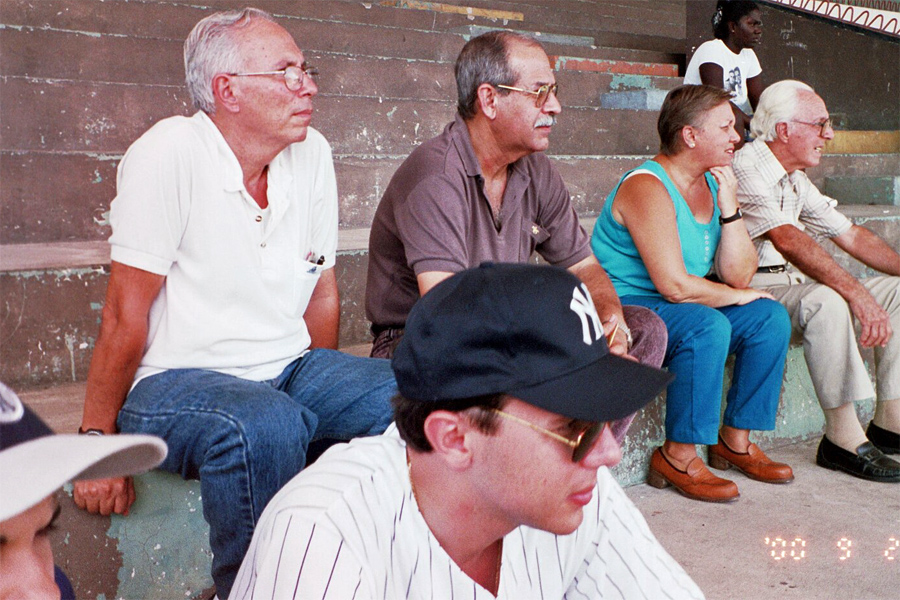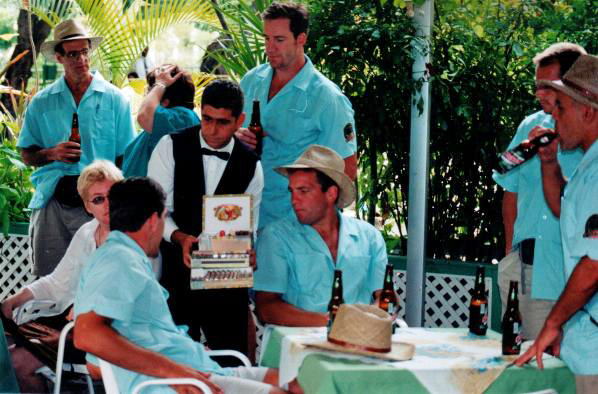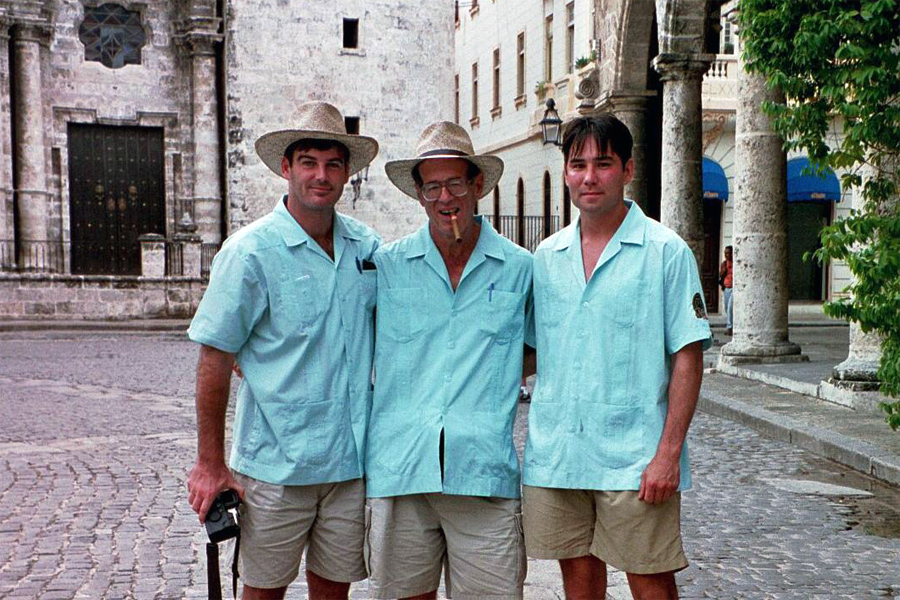September 2000: Atlantis
Resurfaces in Cuba
Emil
Signes AKA Emilito
14 September, 2000
JUNE 20, 2013 (rev. July 11, 2013)
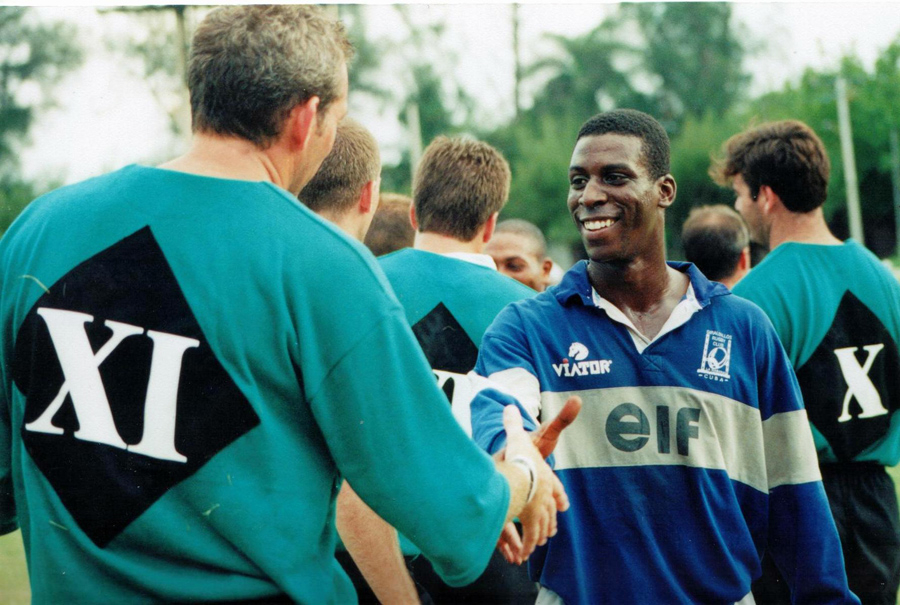 This picture represents all the best of this
tour. Keith McLean and Alexis Figueras after the
Atlantis-Cuba match
This picture represents all the best of this
tour. Keith McLean and Alexis Figueras after the
Atlantis-Cuba match
Ciudad de la Habana, 29
August - 4 September 2000. Ordinarily a 5-team sevens tournament would be
considered an embarrassing failure. Nevertheless, when
the players of the invitational club Atlantis walked off the
field following their defeat of the Cuban national team,
everyone involved considered the event a phenomenal success.
Furthermore,
although the tour was validated by the rugby, it was only a
small part of what was, for all of us, a profound and unique
"life experience."
Al Dekin - My reflections of the tour are
full of superlatives. Of all the places I've been, all the
things I've done in rugby, this is at the top of the list.
Mike Skahan
- This was the best trip of my life. A life which I
appreciate more each day.
Atlantis won
the tournament with three victories, then played a one-off
match vs. the Cuban national team. This was the
first-ever sevens in Cuba, and despite their inexperience, the
Cubans had tons of athleticism and Atlantis had had to work
very hard. "We've got to play well," said wing Mike Skahan
before the game against Cuba, "they've got some
players!" Indeed they did.
1. Genesis
Rugby in Cuba? I pride myself on leading teams
to unknown rugby wildernesses, but it never crossed my mind
that they had even heard of rugby in Cuba, let alone played
it. Then one day I found a reference to a "Havana Rugby
Club" on a web site Mauricio Sanmartín had developed for the
Caribbean Rugby Union.
Roots.
As a result of an obsessive search to fill out my family tree
begun in 1997, I wanted to return to Cuba, my mother's place
of birth, and home to 30 relatives. I had once known
these relatives very well. During the entire decade of
the 1950s an entire crew would spend most of the summer at our
house. The Cubans' visits were something we looked
forward to: they were fun! And in 1955 my parents,
siblings and I spent a month with them in Havana.
1999 Visit. Desperate to visit, I
found I could do so under a "general license", visiting close
relatives in circumstances of humanitarian need. With my
beloved tío Bebo 80 years old and in ill health, I needed no
more validation.
I was so
profoundly affected by the visit that I wrote a 65-page "trip
report" for the 100-member US branch of the family. I noted
that after 24 hours in Cuba, I was so distressed by the
conditions in which our family was living that I not only
cried but also wanted to leave. At the end of the week,
however, I was impressed with the strength, dignity and
ingenuity with which the Cubans dealt with their situation,
and I felt pride and even honor in being able -- on at least
an emotional level -- to share their suffering.
And I found
rugby players!
At my request,
a Cuban cousin tracked down the University of Havana captain
and arranged for me to visit a practice.
At 5 PM on
April 27, 1999, I met some members of the U. of Havana team,
including club president Chukín Chao. I asked Chukín if
they'd be willing to entertain a sevens tournament. He
said of course.
When I left
Cuba, besides 1001 emotions I felt over the fate of my family,
I was determined to inaugurate sevens in Cuba.
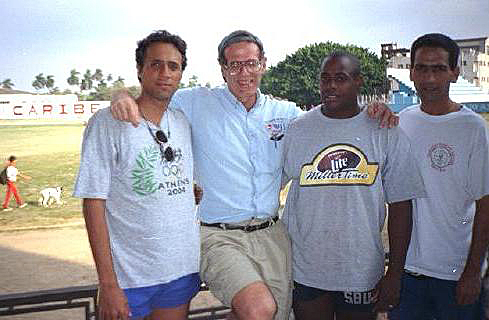 I first met Cuban rugby players in April 1999
I first met Cuban rugby players in April 1999
2. Getting our
Ducks in a Row
José
Antonio Suárez. Without my cousin José Antonio
this tour would have never happened. Not only had he
made it possible for me to find rugby on my first trip, he
salvaged this effort. Chukín, due to the lack of
official status of rugby in Cuba, was unable to get us
invited. Somehow, José Antonio tracked down Marcel
Garrigues, a Frenchman with responsibility for developing
rugby in Cuba.
Marcel
Garrigues. Marcel was able to do what Chukín could
not, and promised not only an invitation but also a
tournament. At this point, whether it was just the
Cubans and we, or a few more teams, didn't matter to either of
us -- the event was on!
Omar Rivera
and the Treasury Department. I invited Omar Rivera
of the Morris (NJ) Rugby Club to manage the team. I knew
Omar would have the motivation to make this happen.
"Made in Cuba," as it were, Omar came to the US in his
mother's belly and was born in the Bronx. He had never
been to Cuba, and jumped at the opportunity.
After
erroneously calling the State Department (most people don't
realize that's it's not illegal to go to Cuba, just to spend
money there -- I bite my tongue and continue --
he was sent to the Treasury Department.
It turned out
this was exactly the type of group they wanted going to Cuba,
and the Treasury Department was a great help in making this
visit a successful one.
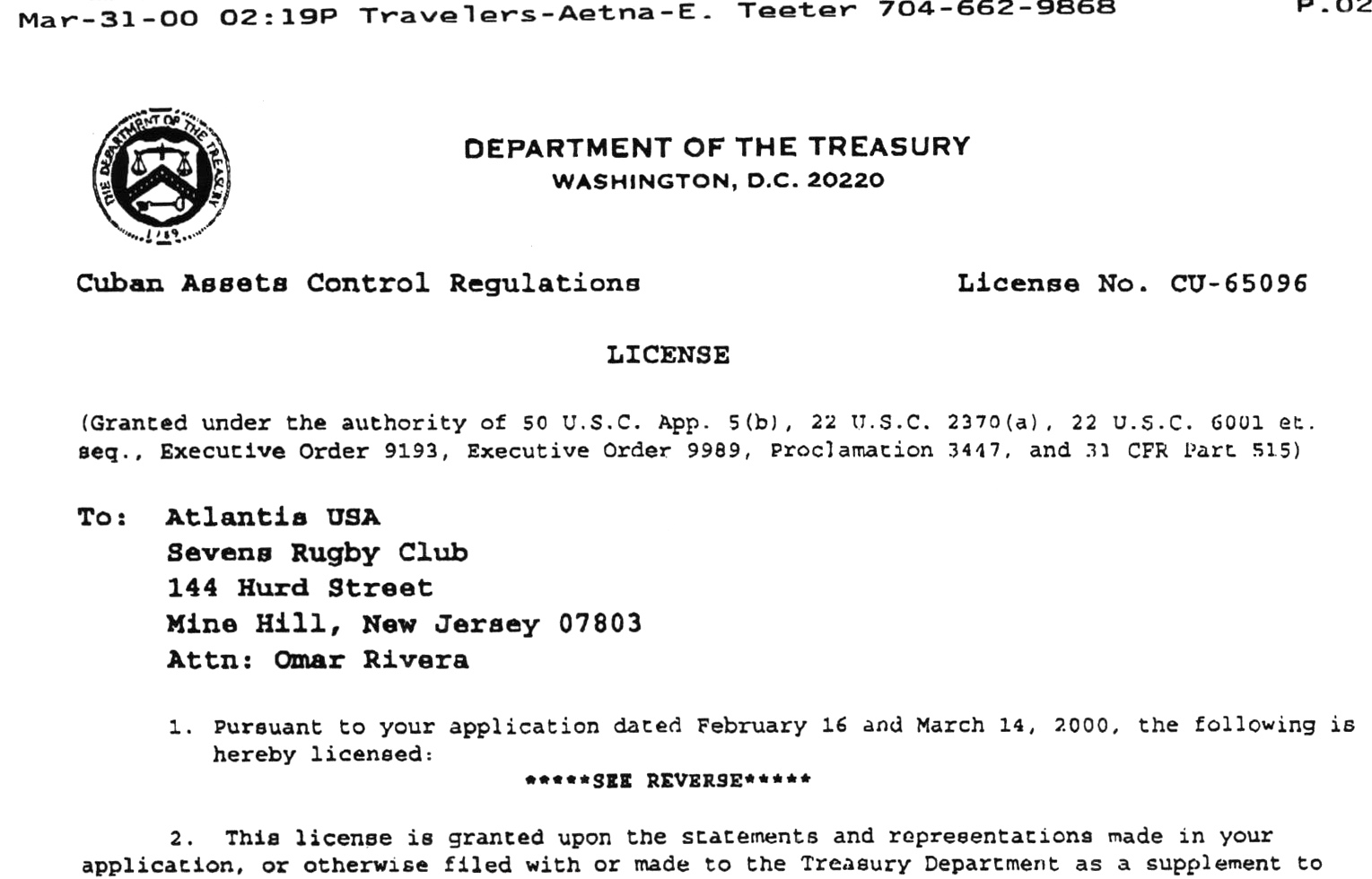
Our objective
to introduce women's rugby on an "exhibition" basis was nixed
by Treasury. Bringing two American teams did not create any
interaction. Still determined, we will try for another
format where we can pre-arrange some genuine interaction.
Omar did an
awesome job. The Morris Rugby Club is lucky to have him.
I wanted one
more "connected to Cuba person" -- Al Caravelli, whose mother
is Cuban. I locked in the 42-year old fitness fanatic,
now fully recovered from ACL surgery, as captain.
Searching
for Teams. We worked hard getting teams to
participate. I personally was in contact with several
Caribbean teams, with the French Froggies, teams from Spain,
Argentina and even Fiji. Although we had several
commitments, we lost all but the Caymans. No worries;
I'm sure next year will be better.
Picking the
Team. I was determined this be a "good guys" team:
this was a very personal experience and I wanted a team that,
besides excellent rugby players, would comprise human beings
sensitive to Cuba's unique situation.
We started with
11 players but lost Vince Granger to a broken arm. We
got a fantastic pick-up with Craig Hartley, who then got
picked to captain the US tour to Jerusalem and was
unavailable. We went with ten.
Atl #
|
Name
|
Age
|
7s Club
|
98
|
Tom Brewer *
|
35/36
|
Old Blue (NY)
|
267
|
Al Caravelli
|
42
|
New York AC
|
290
|
Mike Coyner *
|
32
|
Fairbanks AK Sundawgs
|
158
|
Al Dekin *
|
34
|
Atlantis
|
154
|
Brian Driscoll
|
34
|
Philadelphia-Whitemarsh
|
123
|
Keith McLean
|
40
|
Philadelphia-Whitemarsh
|
398
|
Steve Robke *
|
30
|
Kansas City Blues
|
426
|
Mike Skahan *
|
28
|
Kansas City Blues
|
34
|
Scott Stephens *
|
38
|
Washington
|
279
|
Jim Walier
|
34
|
Philadelphia-Whitemarsh
|
|
* = US Eagle
|
|
|
Despite the average age (35+), everyone was fit,
including Tom Brewer, who hadn't played in more than two
years. There were no Atlantis rookies on the team,
possibly for the first time ever. (We managed a rookie
show anyway; that's just the way we are.) My highest
expectation of each and every player was realized.
Dick Elliott
[VP of the Florida RU and Executive Director of the Florida
Rugby Foundation, former Secretary of USARFU and B-1 panel
referee] - "Of the 14 foreign tours I've been on, this tour
created the most good will for US relations in foreign countries
and rugby relations as well. The players were super
gentlemen. As opposed to the 'ugly American,' these
players were all beautiful Americans."
Doc Sue
Bercuk -- I feel quite honored to be invited to
serve as Team Physician. The gentlemen of Atlantis
succeeded as American Rugby Ambassadors to Cuba.
Al
Caravelli - The team chemistry was one of the
best, -- perhaps the best -- of any tour I've ever been
on.
Atlantis
Trivia: Scott Stephens set the record for most elapsed time
between first and latest Atlantis appearances: 14 years and 2
months.
The non-playing
members of the team were
Omar Rivera,
Manager (Morris (NJ)
Sue Bercuk,
Team Physician (Gentlemen of the Blue Goose, Summit HS [CO])
Emil Signes,
Emperor and Coach
Heide Signes,
Empress
Dick Elliott,
Referee, and, last but not least,
Warren Weiss,
Honorary Chairman
3. The Trip
Nassau and Atlantis. Although there are flights from the
US, they are charter flights, only take place twice a week, and
are expensive and overall unattractive options. We all met
up in Nassau on Tuesday August 29 and left from there. Some
of us went early (my wife Heide and I went on Sunday as a belated
35th anniversary celebration) and bopped around Nassau for a day
or two. It rained the whole time, but I'll always have the
fond memory of my (supposedly very popular) Bahamian breakfast of
sardines and grits.
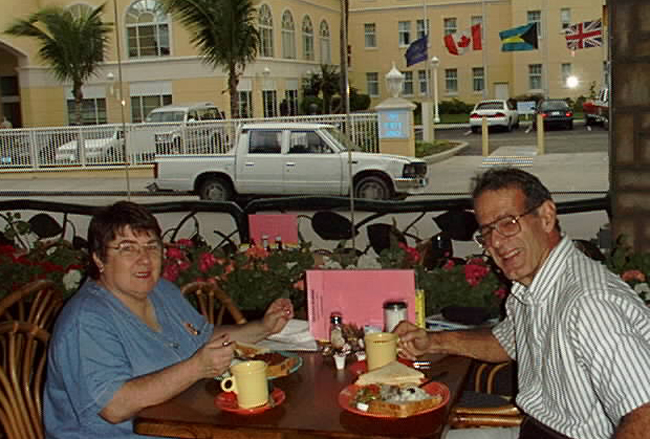
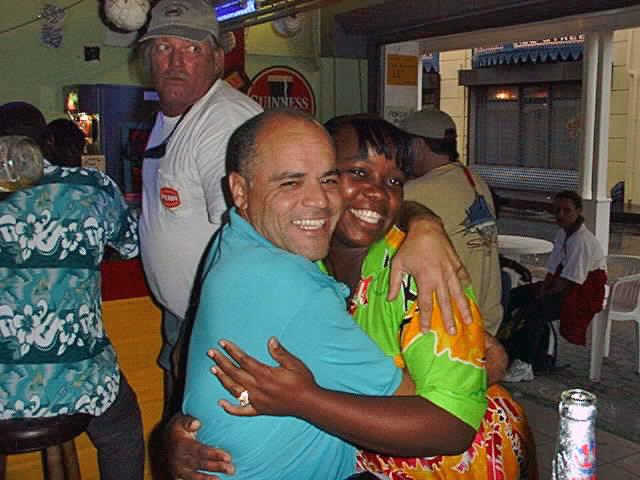
In Nassau. Left: Emil & Heide breakfasting on sardines
and grits /// Right: Omar schmoozing our waitress at Conchy
Joe's
One Guayabera
I'm
wearing
One
Guayabera
One
Guayabera
I'm
wearing
One
Guayabera
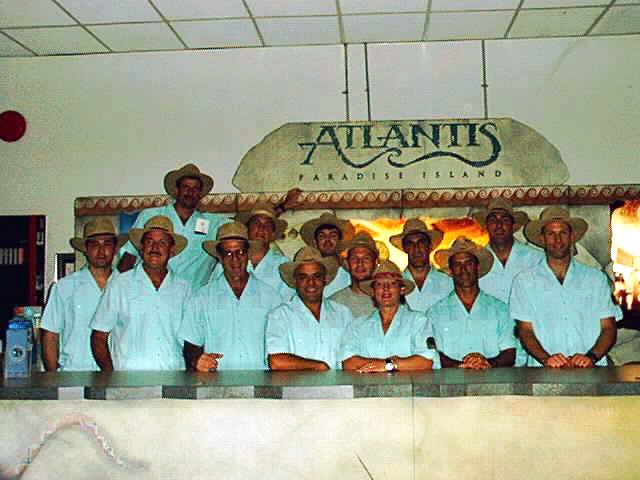
We stop at the Atlantis hotel booth at the airport
Back: Scott Stephens, Tom Brewer, Brian
Driscoll, Mike Skahan, Jim Walier, Keith McLean
Front: Mike Coyner, Dick Elliott, Emil Signes, Omar
Rivera, Sue Bercuk, Al Caravelli, Al Dekin
Atlantis US Sevens Rugby, by
the way, predates the Atlantis Hotels by several years
Just before our plane took off, the lower half of the cabin
filled up with some misty and unexpected (to us) substance.
Turns out they were just fumigating, but it was a bit scary, and
inspired this bit of humor (author unknown) ...
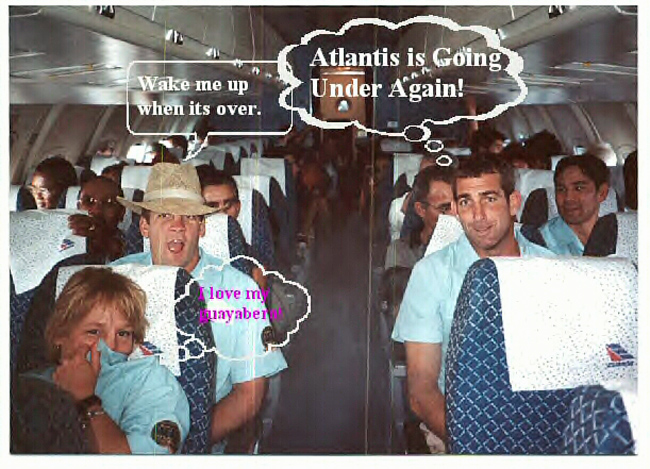
Atlantis in Misty Plane (humorist unknown)
We
arrived at the brand new José Martí airport terminal, got
through immigration and customs quickly, and were met by Marcel
Garrigues and Paúl Ruiz Mena.
4. Our Hosts
Hostal ICEMAR.
The Hostal ICEMAR (pronounced ees-eh-MAR, run by the Ministry of
Education and standing for "Educational Scientific Interchange
by the Sea") was perfect for our needs. With three meals a
day included for $29 (room and board both), you’d wonder about
the quality of the food, but it was excellent.
The hotel, on
Calle 16 in Miramar, has an outdoor pool, restaurant, 24-hour
bar, and is about 100 yards from the Straits of Florida and a
[sandless] beach.
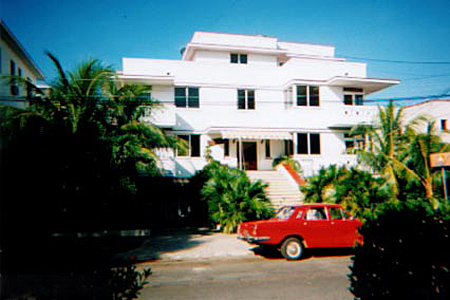
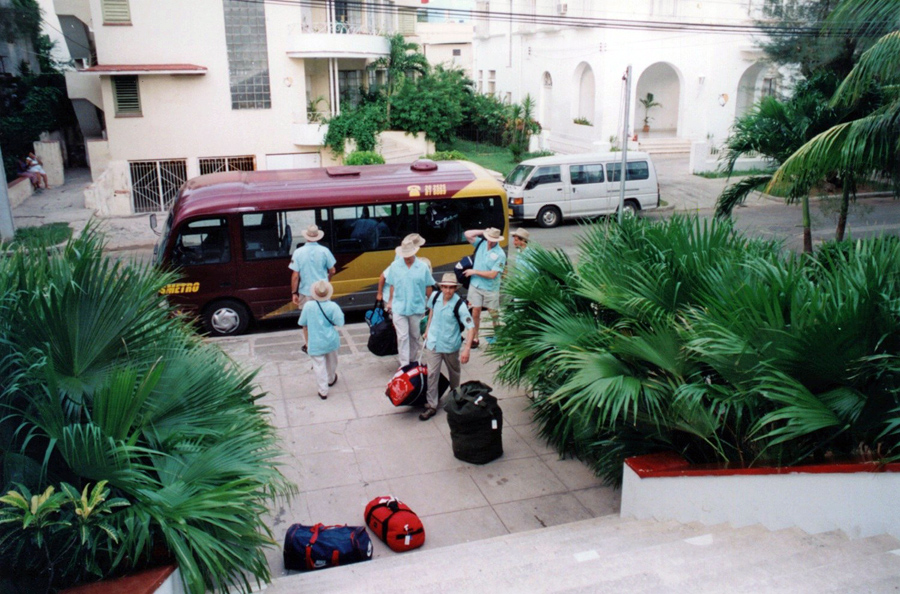 Left: our
hotel, the Hostal ICEMAR // Right: unloading our stuff from
the minibus
Left: our
hotel, the Hostal ICEMAR // Right: unloading our stuff from
the minibus
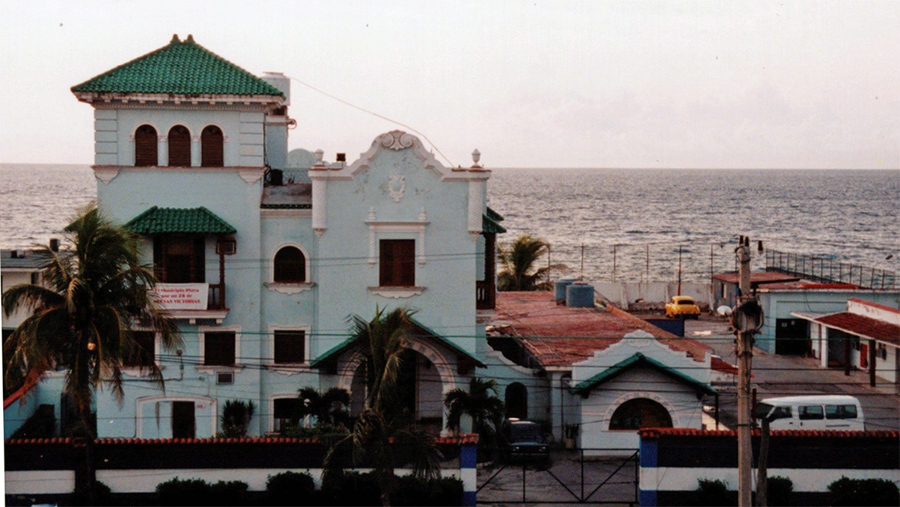
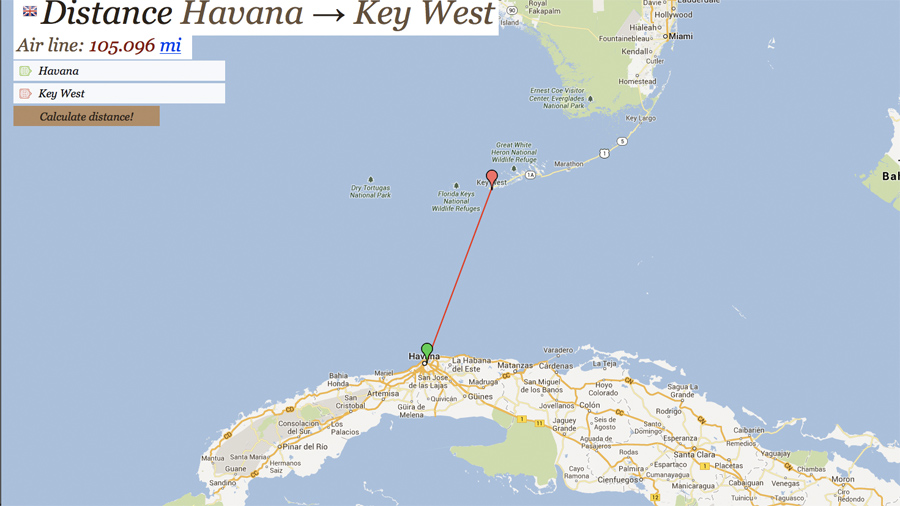
Left: View looking left from our hotel steps (north);
if you could see 105 miles, you'd see Florida
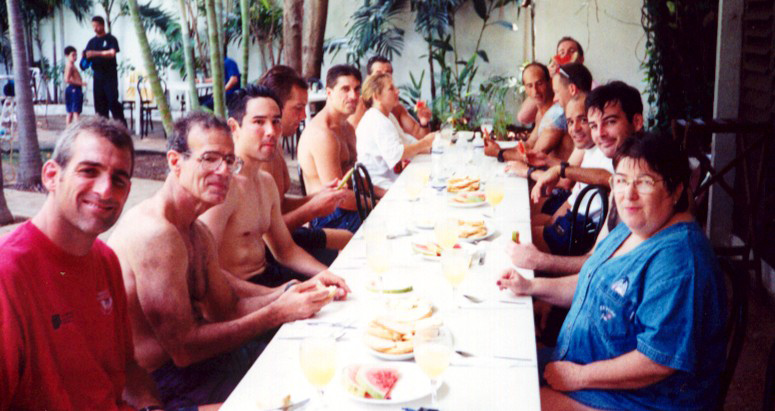
Lunch at ICEMAR. Our lunch was outdoors, half a
block from the hotel, in the same area as a swimming pool
The rooms were
fine, but the plumbing left a lot to be desired (if you had no
need for a shower and didn’t mind your deposits not being
flushed until the water truck came, it was perfect). I had
tried to prepare the tour party for eventualities like this, and
everyone took them in stride.
Scott
Stephens – “I really missed peanut butter and jelly
sandwiches, cocoa puffs, and hot showers. It was a small
price to pay for an experience like this.”
The hotel staff
was warm, friendly and helpful. The guys had a lot of fun
with the neighborhood kids, who ended up with new baseballs,
wiffleballs, bats, etc. For the rest of the week, we never saw
one particular kid that he wasn’t dribbling his new basketball
in front of his house over and over and over again.
Of course in the
entire neighborhood there was no court, no backboard, no basket,
no . . . no nothin'.
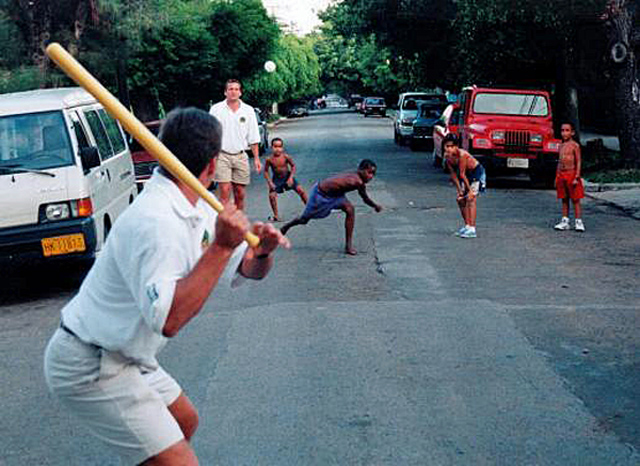 US vs. Cuba whiffleball on 16th Street
US vs. Cuba whiffleball on 16th Street
Paúl
Ruiz Mena. Our liaison became a wonderful
friend. Paúl, 6'4 - 290, is a 38-year old former world
class shot-putter and many-time Cuban national champion.
(His Cuban record of 20.28 meters, set in Rostok, stood for 12
years until finally broken this May.) Despite many medals at Pan
American and other international competitions, Paúl never
competed in the Olympics. In 1984 and 1988, when he made
the team, Cuba boycotted. In 1992 he failed to make the
team, but qualified for Atlanta in 1996. Unfortunately, he
tore his Achilles tendon -- playing rugby.
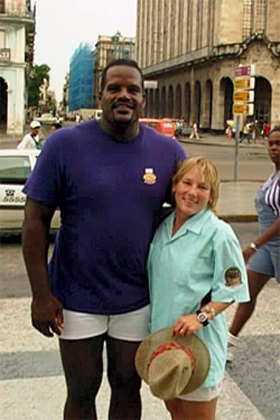
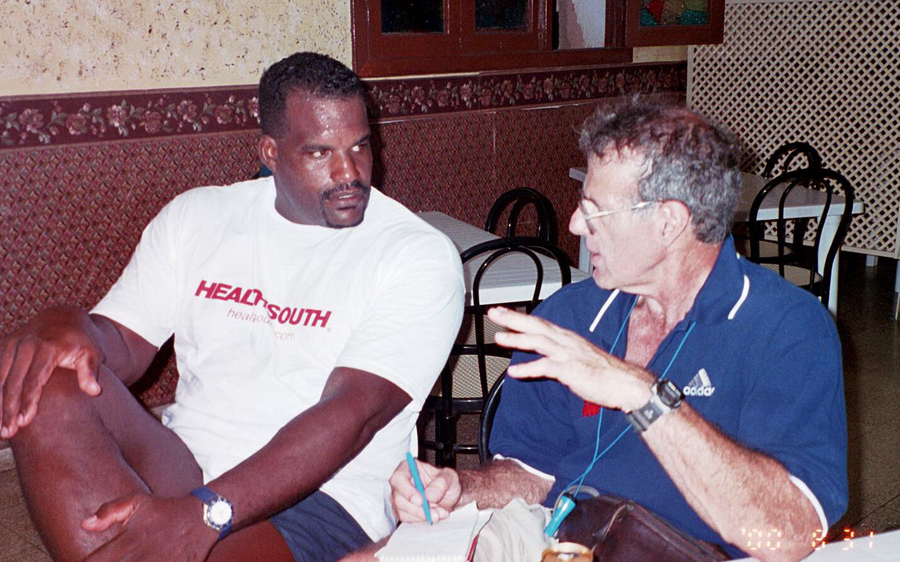 Left: Big Paúl, Little Sue // Right: Emil
interviews Paúl about his shot-putting career
Left: Big Paúl, Little Sue // Right: Emil
interviews Paúl about his shot-putting career
Cuba, who decries
other nations' stealing its athletes for money, has recently
recognized all athletes that represented their nation for more
than 10 years (such as Paúl). These athletes now receive a
pension for life. The amount? 400 pesos ($20) a
month.
You may smile, or
wince, whatever – but it’s nearly twice the average Cuban
salary.
Paúl currently is
the coordinator of the Committee for the Promotion of Cuban
Rugby, a French-sponsored organization that falls under the
auspices of INDER (the National Institute of Sport).
Giovanni? /
Yovani? Marcel had arranged a 24-seat bus. Giovanni
was the bus driver and he was to be constantly available to take
us wherever we wanted to go, day and night (after hours for a
few extra bucks, of course).
July 2013: I notice I've written our
driver's name both as Giovanni and Yovani, and given the
predilection of Cuban for "Y" names since the revolution, my
guess is Yovani is correct. As I write in July,
another "Y" Cuban is becoming well known in American
baseball - Yasiel Puig.
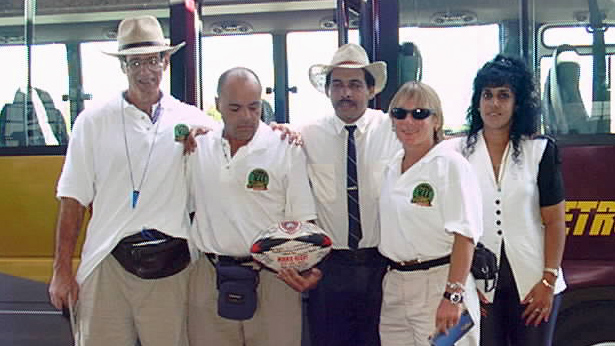 At our bus at the airport on our return. Our
driver Giovanni? Yovani? is in the middle
At our bus at the airport on our return. Our
driver Giovanni? Yovani? is in the middle
5. The Relatives
(Note: In
describing relationships, I use the Spanish custom of using
nephew and niece not just for siblings' children, but also
cousin's children, rather than the "xth cousin y times removed"
that English prefers. All the nieces and nephews I refer to here
are children - or grandchildren - of cousins)
Emil's
relatives. I was pleased to see four relatives
waiting at the hotel. From last year's visit, I knew they
could use clothes, medicine and good hard dollars. With
the help of relatives stateside -- and other tour party members'
sharing the load (more than 100 pounds of medicine and clothes,
which I could never have brought in had I traveled alone), I was
able to distribute goodies.
Some of my relatives // Left
at ICEMAR bar
Right: more of my relatives // Atlantis relatives made up up a
large portion of the spectators
Sadly, José Antonio, who had helped me so much to help
make this happen, is a Yankees fan :(
Omar's
relatives. After dinner, Omar was surprised by a
cousin he had never met before. It was very emotional for both
of us as we sat in the hotel bar chatting with our relatives.
Omar was beginning to understand.
Omar
Rivera - I didn't expect I would enjoy this trip as
much as I have. The people were awesome and the rugby was
great. Seeing the family -- my cousin Lucy who I had never met
was here to greet me -- was something special. I was
overwhelmed by the experience.
Later in the
week, Omar was reunited with Arturo, a half-brother he had only
met once before, and got to meet his nephew Arturito for the
first time.
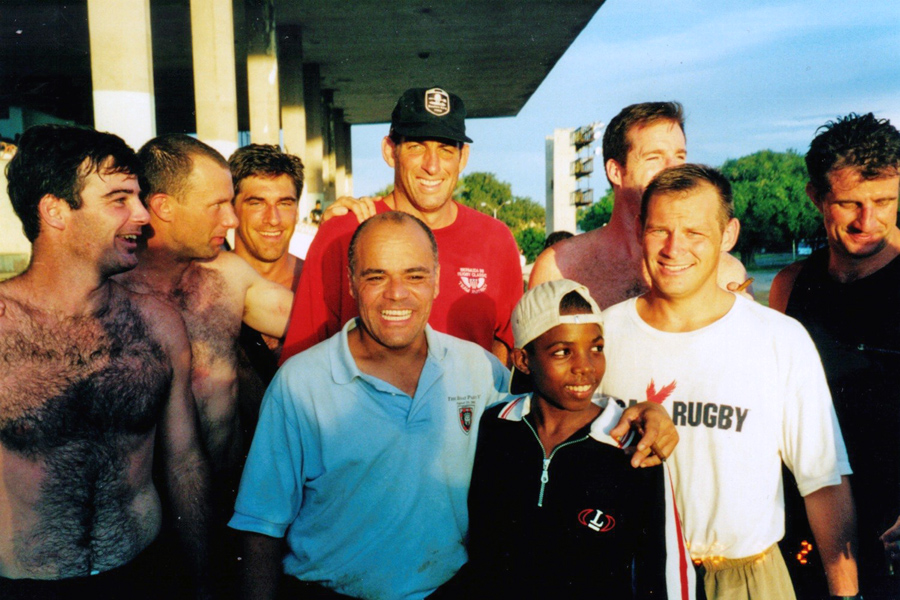
After
games: Omar meets his nephew Arturito, who gets to meet the
Atlantis team
Al's relatives. Al's relatives --
a whole bunch of them! -- showed up a day later. I had felt that
this whole relative experience was something that Al wouldn't
really "get" until it happened, and I was right. But when
he got it, it hit him like a hammer, and the same light that
shone for me in 1999 shone for him this year.
Al
Caravelli - This trip exceeded all my expectations,
anything I could possibly think of. In anticipation of
meeting my family (for the first time since I was a year old), I
expected to feel a deep depression. But they were so happy
to see me that it gave me great joy. Speaking to a cousin
of mine, she told me that I just gave each of my aunts &
uncles an extra year of life.

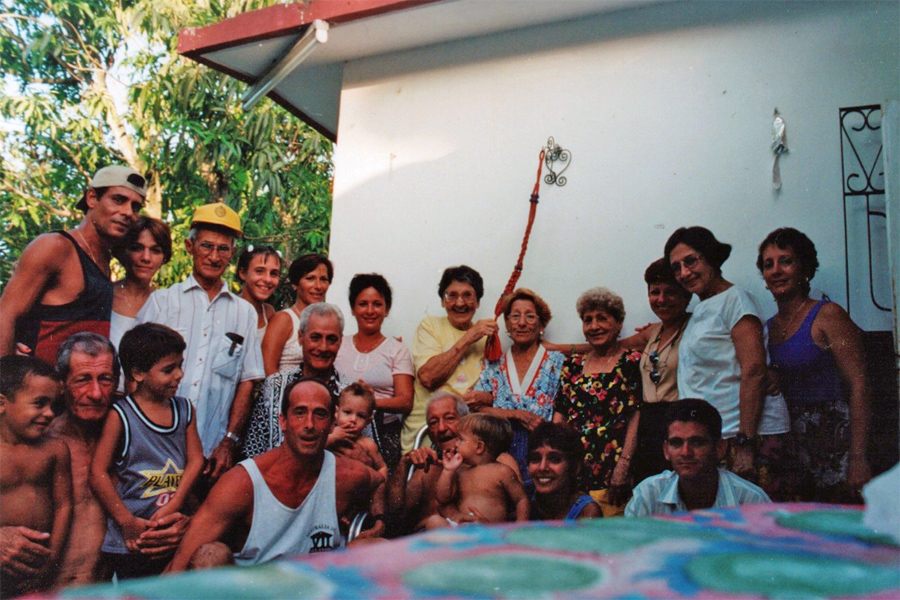
Left: Omar and his cousin Lucy // Right: Al and his large
Cuban family
Besides sharing relatives, the
three "Cubanitos" shared an ice cream stop during our travels.
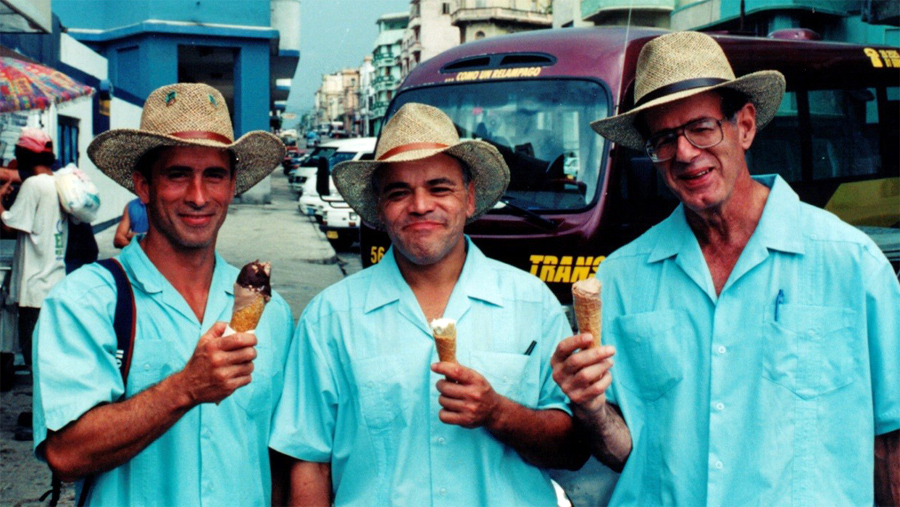 Los cubanitos indulging a desire for ice
cream
Los cubanitos indulging a desire for ice
cream
6. A Visit
to the US Interests Section
As a group
licensed to visit Cuba, we were invited to a briefing at the US
Interests Section (USINT).
Public Affairs
Officer Larry Corwin was our host, and his discussion was far
ranging and informative. Among many things he told us was that
there is NO embargo on food or medicine! According to
Corwin, the lack of medicine available to the average Cuban is
largely the fault of the Cuban government, who wants to blame
the US and the embargo.
A large number of
Cubans work at USINT. Nevertheless they officially work
for the Cuban government, which receives payment in dollars and
turns around and pays its employees with the same number of
pesos, or 5% of what USINT pays the government. [This is
the case for all foreign employers; a cousin that works in a
Havana hotel related the same story.]
To make sure
their employers get a living wage, USINT -- -- as do other
foreign employers -- turns around and provides them with a
"jaba," a Cuban custom of giving gifts with payments. In
the case of USINT, the jaba equals their pay in dollars.
Thus to pay them once, we pay them twice.
Larry also
defended the government's continuing support for the embargo
(how could he not? It is our government's policy and he is a
government employee).
I have to put my
two cents in. If I try to cut through everything I've ever heard
our government say about the embargo, all I can figure out is
we're afraid if we drop the embargo with nothing in return
Castro will unilaterally declare victory. That seems like
misplaced machismo to me. If there is one thing on which
every Cuban with whom I spoke agrees, it is "End the
embargo! We are the ones suffering, not our leaders."
Brian
Driscoll - I found the Cuban people's generosity,
curiosity, and acceptance to Americans overwhelming, especially
considering the obvious hardship they are under. The
embargo's gotta go!
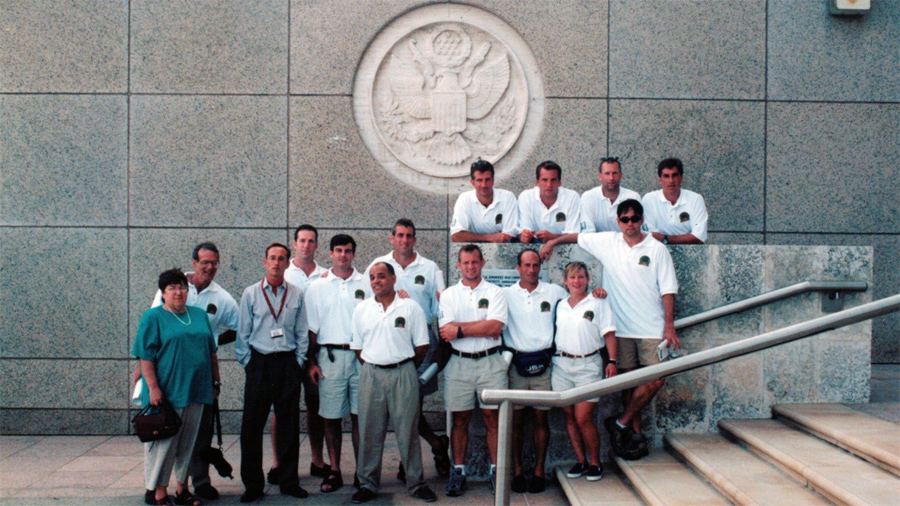
Atlantis at the US Interests Section
7. Habaneros and
their life
As
much as we enjoy the sights, we are taken even more by the
Cuban people. The following quote from Christopher Baker
in The Havana Handbook reflects our experience: "The
Habaneros (residents of Havana) are perhaps the most
remarkable part of this remarkable city. The rest
of the world could do much worse than see them as role models.
It is not simply the noble way they demonstrate how to squeeze
pleasure out of adversity. Cubans are so unstintingly
generous, so gracious, so full of decent, considerate behavior
that they exemplify a more elegantly human way of being."
Baker credits the
Revolution: "This 'New Man' is the very essence of the
Revolution, . . . " I don't buy that: the Habaneros I knew
were just like that in the 50s.
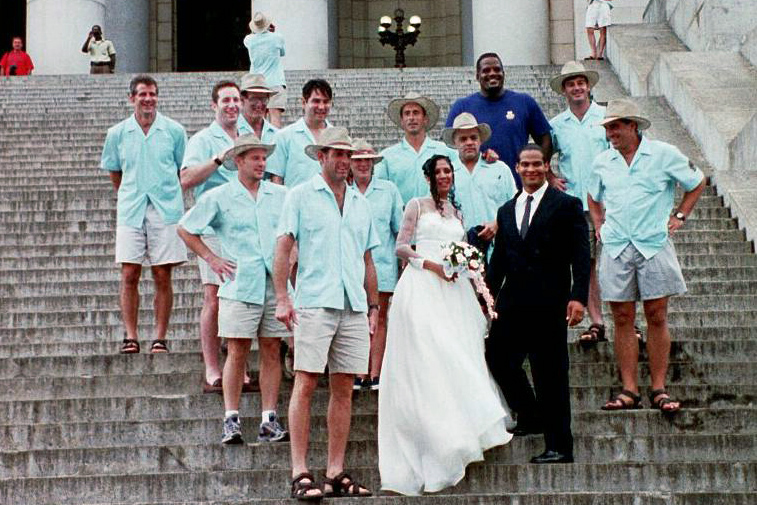
Cuban couple takes it with good humor as we crash their
wedding picture on the steps of the Capitolio
The Capitolio, based on the US Capitol, is now only used
for tours and offices
Keith
McLean - I was surprised most by the positive way
people reacted to us being there in Cuba. The people were
personable, polite and humble.
Keith was to comment later that "Even the hustlers were
polite."
Dollars, Pesos
and Food. Cubans are paid frighteningly low
salaries. I remember last year, after I had checked into
the hotel and tipped the bellhop $6, sitting in the hotel bar in
stunned silence as relative after relative spouted off their
salaries, which ranged from $7 a month (designer) to $15 a month
(computer engineer). Beers here were $1.50 each. I
made a quick calculation – if the average Cuban professional
made $10 per month, then this $1.50 represented 15% of their
monthly income. For an American making $36,000 per year,
15% of monthly income would represent a price per beer of
$450. The round of 8 I had just bought would cost
$3,600. That would be a world we certainly couldn’t afford
to be in at our expense. I realized then that everything we did
together would be entirely at my expense. Not that I had a
problem with that; it was just the enormity of the disparity
that stunned me.
It then struck me
that I had just tipped the bellhop the equivalent of 2 weeks
wages for an engineer.
The Cuban system
is designed to prevent the accumulation of wealth. The
only ones that come close are those with access to
dollars. Economically, it's better to be a bellhop than an
engineer; better to be a whore than a doctor.
Although each
Cuban receives a ration book each year allowing the purchase of
food and other supplies at government-subsidized prices, those
items are often not available. Last year my uncle showed
me his "libreta," or ration book, which had cooking oil checked
off in January, but in no subsequent months: it just hadn't been
available. Well, it probably was available, but in
dollars, at prices roughly equivalent to those we would pay in
the US. An engineer nephew commented to me last year, "See
this water glass, it cost 85 cents. That's more than I
make in a day."
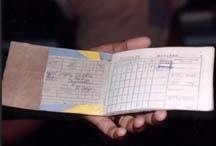
Page from a Cuba ration book, "la libreta"
I was able to
find some actual numbers from a Washington Post web site.
It states that the 1999 average salary in Cuba was 221 pesos (or
$10.50 at the current 21:1 rate) per month.
The rationed
quantity and pesos per month for food and supplies follows.
Rice; 6 lbs.;
1.50
Sugar; 6 lbs.;
0.75
Legumes (half
peas, half beans); 1.5 lbs.; 0.48
Coffee; 0.25
lbs.; 0.80
Eggs; 12; 1.80
Meat; 1 to 2
lbs.; 0.75 to 1.50
Cooking oil;
0.125 lbs.; 0.15
Salt; 1 lb.; 0.10
Fish; 1 to 2
lbs.; 1.00 to 4.00
Laundry soap; 1
bar; 0.20
Bath soap; 1 bar;
0.25
Tooth paste; 1
tube; 0.65 to 1.00
A daily
2.8 oz. of bread per person is subsidized to 0.05 pesos. In
addition, there are a couple of items subsidized for children
only. Through age 6, 2.1 pints of milk are available daily
for 0.50 pesos, and from ages 7 to 13, 6.3 pints of soy yogurt
weekly costs 3.00.
Great prices, you
say. For example, 6 pounds of rice costs 1.5 pesos (or 7
US cents). Yeah, that's true, but if they don't have it,
you must pay American prices of perhaps US$3 or more for 6
pounds (or more than 40 times the subsidized price). In
this case, rice alone would represent 30% of an average Cuban's
salary.
It's an
absolutely bizarre system, and economically, I can't think if it
as anything but a dead end.
To quote Miss Clack in The Moonstone, "I could write
pages of affectionate warning on this one theme, but (alas!) I
am not permitted to improve, I am condemned to narrate."
Cubans and the
Revolution. Given their very difficult existence,
one would think that Cubans would be champing at the bit to get
rid of their current government. It doesn't, however, seem
to work that way. It's not that most are happy with it,
although there is a hard core of supporters of the
Revolution. These are people that remember (or remember
through parents and grandparents) the corruption of the Batista
era and the influence of the Mafia and the lack of education and
health benefits to the poor in those days. The Revolution
brought some positive changes to Cuba.
Fidel Castro is
also a very convincing person, and the embargo has allowed him
to divert blame for Cuba's economic problems from his own
bankrupt economic system to the US embargo.
As the economic
system continues to sputter, the number of unhappy people
increases. There is, however, a huge problem for the Cuban
people -- a seeming lack of viable alternatives.
Cubans and
Cuban Exiles: No Mas Canosa. Despite a genuine
disenchantment with their government, many Cubans see few viable
options. They are certainly not drawn to the politics of
the Cubans exiles in the US. Their politics, as embodied
by the late exile leader Jorge Mas Canosa, offend Cubans even
more than those of their current government. The following
reflects a conversation I had with an anti-Castro Cuban:
“The Cubans who
left in the 1990s, even in the 1980s, we respect. They
still remember what it’s like, they know what we have to go
through, and they have compassion for us. The Cubans who
left in the 1960s, however, are a different story. They
resent us, they have no idea what our lives are like. They
even refuse to come here, so they’ll never know. As bad as
things are here, we’d rather stick with what we’ve got than be
subjected to those guys. They should stop calling
themselves Cuban and just be content with being North
Americans. I have no respect for them.”
Cuban Police.
Havana has got to be one of the safest places in the
world. No matter where you go there are police, and they
do assure order. Unfortunately, this safety comes at a
price. We see people stopped regularly. Several
reasons are given. One is the need to keep prostitutes and
hustlers (jineteras and jineteros) off the street. Also --
you're not allowed to live in Havana without the government's
permission. Thus if someone from outside the city is
"carded," s/he must answer a lot of questions as to why they're
there.
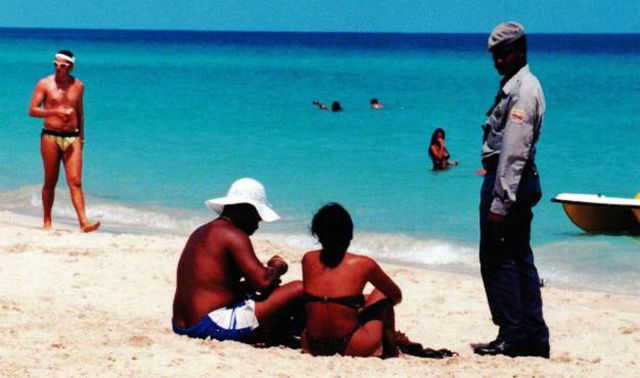 Police carding people on the beach
Police carding people on the beach
At the hotels,
Cubans are kept from visiting the guestrooms. One of many
criticisms of the Batista regime was that it practiced "tourist
apartheid." Well, folks, tourist apartheid is alive and
well in Castro's Cuba.
Apparently the
police do more than just question people. Amnesty
International notes several cases of people sent to jail for
months merely for criticizing the government in public.
When walking
through Old Havana late at night and seeing so many police, it
does make me feel good, and safer. Then, knowing all the
other things going on, I feel guilty about feeling good.
Mike
Coyner - Its not often that we as Americans stop to
appreciate the little things in life like running water, fresh
foods, and the Freedom of Speech but if you've ever been to
Cuba, you will stop. Imagine if every person in America
who publicly questioned or bad-mouthed President Clinton were
incarcerated.
Politics aside,
the rugby was good, the cigars were/are great, the beer was
cheap, and the people are warm-hearted.
8.
Rugby Practices
With the entire
Cuba experience swirling around us, we don't forget why we're
here. On Wednesday, our first morning in Cuba, we leave
for practice at 9 AM. We practice at
the field we are to play on. There are no posts, no
lines, and half the field has grass a foot high.
Half a dozen people are working on it, though. One
is using a lawnmower a foot wide rolling on wheels made of
rebar. While running practice, my view across the street
is of a long sign stating "Creemos [we believe] en Fidel,
la Revolución, y el Socialismo."

Across the street from the field: "We believe in Fidel,
in the Revolution and in Socialism"
Thursday we
practice again. To use half the field we
help the workers move about 30 piles of cuttings.

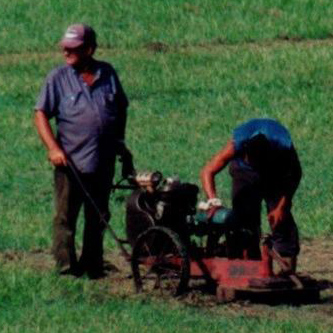
Left: We moved lots of piles of grass cuttings do give
us a area in which to practice // Right: tiny mower for this
big field
We planned a
joint training session Thursday afternoon with the Cubans, but
there is a huge thunderstorm and we wait to leave the hotel
until it ends. We get to the field and find out the Cubans
had left at the start of the storm. I'm willing to call
off the practice but the players push to do something.
"Something" turns into an intensely competitive session between
the oldest five and the youngest five (Coke v Pepsi) that I
abort early in order to save some of that "attitude" for
Saturday.
Doc Sue
Bercuk: Indefatigable. Doc Sue is an amazing
resource, who never ceases to go above and beyond the call of
duty. Our aging team was pretty banged up (Stack Stephens'
described himself as "falling apart"), but Sue's non-stop
ministry kept everyone healthy (no one missed a minute because
of injury) and the players were grateful. As were a couple
of Cuban players whom she attended during the tournament.
Then there was a guy on the street with a broken arm who fell
and damaged the sling he was wearing. Sue just happened to
have a sling on hand and fixed him up.
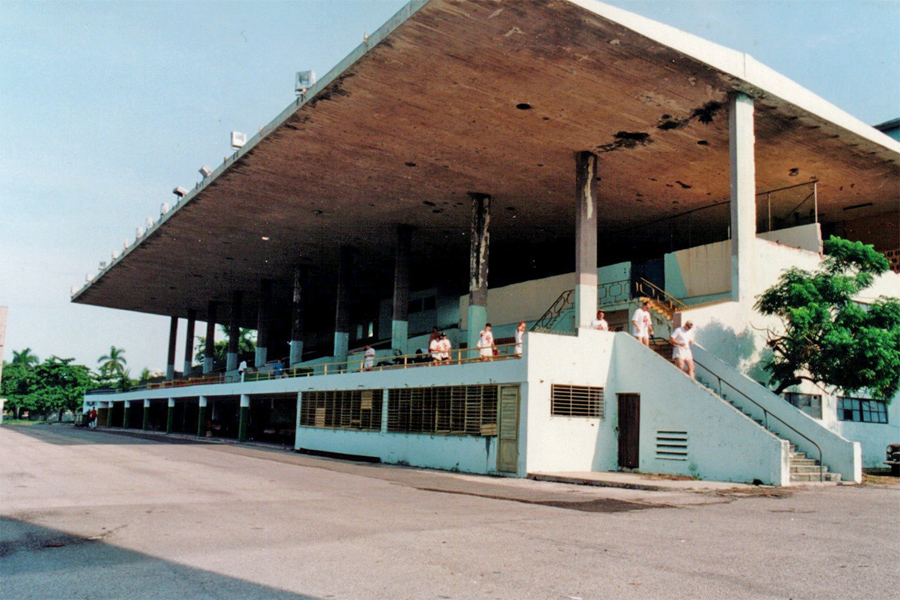

Left: the stands at Saborit Stadium // Right: Doc Sue
works on Tom before practice
Doc
Sue Bercuk -- I felt so open-hearted and being able
to help people was very meaningful.
9. Rugby in Cuba:
A History
History. I
learned some more about the history of rugby in Cuba, partially
described in a 1999 issue of Rugby.
First played in
Cuba in 1992, rugby existed only at the University of Havana
until 1998. There are now three teams, with a fourth
beginning. All clubs are in Havana, but expansion is
planned.
In 1999, INDER
recognized rugby only as a recreation and not as an official
sport. Rugby's status has improved since then (Chukín was
able to invite the Tucson RFC to visit), but still has a long
way to go. We have informed INDER of our positive
impressions of the tournament, and hope this will help. The
inauguration of rugby as an Olympic medal sport will be a huge
boost.
Just as we were
surprised that they played, many Cuban rugby players were
surprised that we play. Now we both know.
While searching
for potential women rugby players, we learned Paúl's older
daughter plays basketball for Cuba U-19. Although this is
not something she's about to give up, Paúl confirmed that she
had some athletic friends. Where there's a will there's a
way, and we've got to track down a few Cuban women with the
will. We can help provide the way.
Last year I wrote
" I’ve asked Chukín for an invitation . . .The first ever Havana
Sevens? Hmmm."
Hmmm indeed.
The French
Connection. One reason Cuban rugby has come a long
way since the days of one team waiting for tourists to arrive is
that they have made a “French Connection” that has formed a
"Committee to Promote Cuban Rugby." Marcel Garrigues is
the President of this Committee, sponsored by private French
enterprises.
The Committee has
a relationship with the French Federation of Rugby (FFR), but is
not yet official because there is, as yet, no formal connection
between Cuba and France with respect to rugby. They are
working on that and Marcel is the official FFR representative in
Cuba.
Tour of
France. Certainly the highlight of Cuban rugby to
date has been the national team’s tour of France between June 4
and July 4, 2000, where they went 2-6.
Of course, the
French sponsored the entire tour; there is no Cuban government
money for rugby. Still, the fact they were allowed to go
means something and the INDER representative that made the trip
came back with a positive impression.
Unfortunately for
future tours, two Cubans decided to stay in France. One
was one of Cuban rugby's greatest catches, Reynaldo Quintero
Álvarez, a former World Junior Champion in the 100-m
hurdles. Fortunately for them, Cuban rugby is getting
athletes!
That's always a
good start.
10.
Boys on Tour
Our tour wasn't
all rugby nor melancholy reflections. Some of it was flat out
fun tourism. We got some bus tours, visited important
sites, shopped at markets and walked through Old Havana.
We made relaxing visits to cafes with musicians playing
traditional Cuban music. Get a drink, smoke a cigar,
mellow out. It was this mode that inspired the following
from Jim Walier.
Jim
Walier - Take a sip of a mojito, Hemingway's
favorite Cuban rum drink, and imagine the scenario: take a team
of veteran rugby personnel to one of the most intriguing places
on the globe and turn them loose for a week. It was an awesome
rugby tour that included challenging rugby, exposure to the rich
Cuban culture and history, pristine beaches, and of course the
great cigars.
Left: Our first exposure to
Cuban cigars /// Right: at the cathedral; I've got a cigar
One of the areas
that I love to visit is the Malecón. In Christopher
Baker’s guidebook he says, “How many times have I walked the
Malecón? Twenty? Thirty? Once is never enough,
for Havana’s seafront boulevard enigmatically seems to represent
all of Havana.”
It’s unbelievable
how so many obviously nice buildings are rapidly decaying along
the Malecón. There is now a tremendous influx of Spanish
money to restore buildings along this great boulevard, and you
can see construction in progress at various spots along its
length.
Keith
McLean -- [One] observation was the
architecture. Although it was very dilapidated, I could
visualize a time when Cuba was a very beautiful place.
Hopefully in the
not too distant future I can see beautiful beaches with
refurbished buildings and houses and a great vacation spot when
and if the political environment changes. I for one would
go back.
Everything people
have told you about 1940s and 1950s cars is spot on. The
Revolution rejected materialism, and if it's goal was to stop
making "things," they were certainly successful; the past is all
around us.
Warren
Weiss -- "I agree with Einstein: time travel
is possible. I feel like I went back to the 1950s.
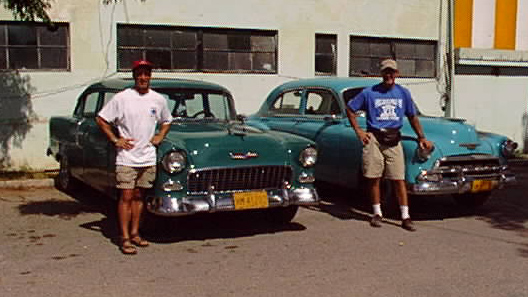
Al & Emil and 1955 and 1953 (I think) Chevies
Friday morning we
spent a couple of hours at Santa María, a fantastic beach east
of Havana. That evening there was a trip to la Cabaña, the
largest fort in the Americas.
Following the
tournament there was another trip to the beach, as well as two
late evenings at Cuban nightspots -- the 12 Apostoles and the
Capri Hotel.
Shopping was a
staple of the tour, as being here on a special Treasury
Department license meant that we were allowed to bring back $100
in Cuban goods. Cigars, of course, were the number one
priority.
Brian
Driscoll -- One observation / question based on our
experience: I am guesstimating that at least 6 million of the 11
million population MUST work in one of the cigar factories
considering how many people approached us who "had friends who
worked in one."
Through our rugby
contacts, we all paid about $40 per box for Monte Cristo #2 or
equivalent. I hear that's a good price.
11. Escuela
Ignacio Agramonte
September 1 is
the first day of school for Cuban children, and we got up at 7
AM to attend the first morning assembly of the new school
year. There were those that would have preferred to sleep
in, but in the end everyone was glad we'd gone.
We visited
Escuela Ignacio Agramonte, a primary school on B Street in
Vedado, invited by one of the Cuban national team players, Iván
Robert Suárez, a teacher there.
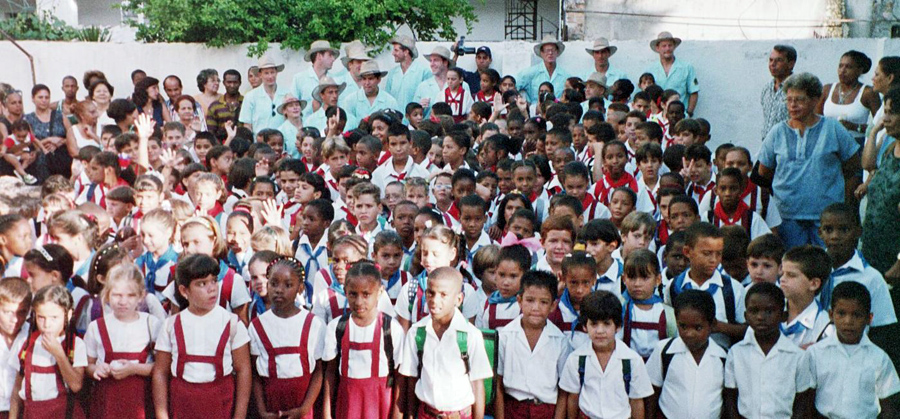
Atlantis players at back of assembly of students at
Ivan's school
In between Tom and Emil is Al's nephew Onil, filming the
proceddings
Introduced as a rugby team from New York, we were invited to a
place of honor on the stage.

Atlantis brought up to stage
Among more
routine statements, the assembly included a declaration of
communism and loyalty to their leader Fidel Castro. At the
end there was a song. The lead singer, a child, sang a
verse "And if the Yankees / Want to come here . . . " The next
line was drowned out by some laughter from the parents, but
whatever she said was accompanied by spraying the audience with
an imaginary rifle.
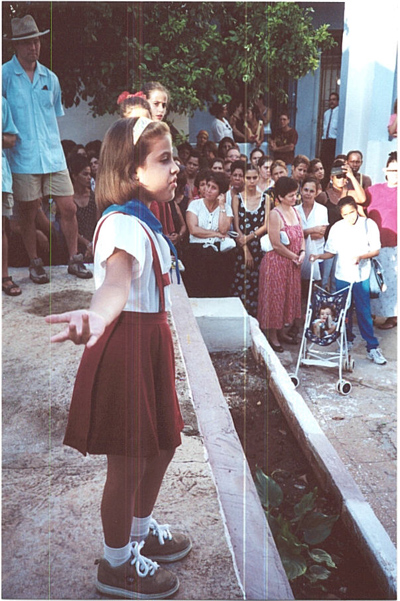 Girl ready to shoot Yankees
Girl ready to shoot Yankees
Click image to view
I had really
wanted to believe that stuff didn't happen any more.
(Well maybe I'm
wrong; she might just be a Red Sox fan!)
Later, one of my
relatives comments "If they could, the people that have the
children sing those songs would be the first to jump on the next
plane to Miami."
On the way out,
we got a brief tour of some of the classrooms. No class
has more than 23 students. As I write, the Boston
schoolteachers (my daughter is one) are threatening a strike
because the school district plans to increase class size from 28
to 31. From my previous visit, I also know that the Cuban
system produces very well educated children.
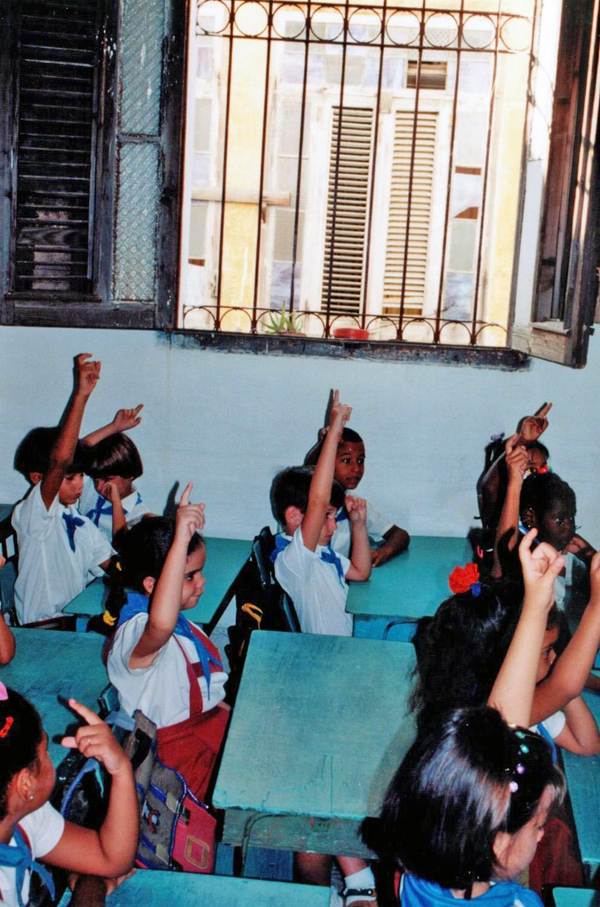 One of the classrooms we visited
One of the classrooms we visited
Steve
Robke - Cuba is a country of contradictions.
The society is poor, but well educated. The buildings are
dilapidated, but the views are breathtaking. The children
are shoeless, but seem happy. The government controls
everything, yet there is no infrastructure. There are
laws, but they need to be broken to survive. To me, Cuba
is a prison with paradise potential.
12. At the Beach
Following the unforgettable Friday morning school
visit we spent a couple of hours at Santa Maria, a fantastic
beach east of Havana. Although we had thought of
fitting in the world-famous Varadero Beach at some time
during the tour, this was just fine. In fact, better:
there were even some Cubans here.
 Everyone
relaxing except Doc Sue, hard at work at Santa María Beach
Everyone
relaxing except Doc Sue, hard at work at Santa María Beach
On the way to the beach, we had noticed a large billboard
prominently featuring Che Guevara, and it seemed like a perfect
photo op. We stopped, donned our guayaberas and Panama
hats, and lined up under the billboard. About a zillion
pictures were snapped, and one was to grace the cover of the
September 29, 2000 issue of Rugby Magazine - all 11x17 inches of
it!
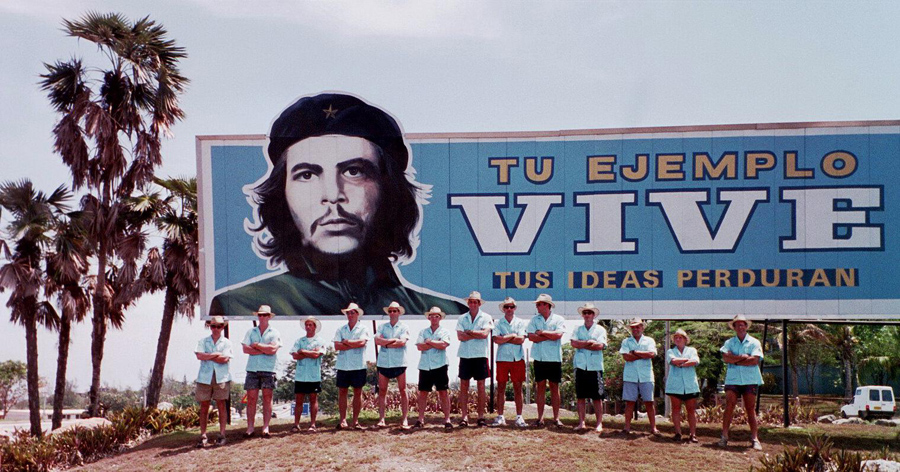 Posing with Che East of Havana
Posing with Che East of Havana
Although Santa Maria was special, it
didn't take too much to make for a pleasurable beach
experience. We even enjoyed the "beach without
sand" 100 meters from our hotel. It's rocky
(sandals recommended), but we enjoyed it. Diana
says it's a popular beach for Habaneros to visit.

Atlantis boys swimming in the beach without
sand at the end of Calle 16
13. The First La Habana Sevens:
the Games

The tournament began at 3 PM and was over by 7. The number
of fans in the stands was approximately zero, which coincided
with the amount of publicity given to the tournament. Al,
Omar and I, however, all had relatives there to watch and that
pleased us. Among Al's relatives was his 22-year old
nephew Onil, who spent several days hanging out with us, and
became the tour chronicler, taking control of the Atlantis video
camera.
Another relative
who really enjoyed herself was my youngest cousin, 29-year old
Roxana, who joined the team for our Saturday and Sunday evening
festivities.
It's hard to
admit, but we're still not sure what the tournament format was;
sometimes you just roll with the punches. After first trying to
have a say in how it would be conducted, then just trying to
find out, we finally said "Just tell us when we're playing at
least 10 minutes before kickoff."
Our first game
pitted us against Martí, and using a classic sevens game plan,
we were able to dispatch them easily by at 40-0 score. They
probably had the ball for less than a minute in the entire
game. We also made quick work of the University team,
34-0.
The third match
was a barnburner. Giraldillos came out determined to take
no prisoners, and these players seemed to have learned something
from their tour of France: the game was punctuated with hard
hits and fists aplenty flying in at tackles, rucks and
mauls. I'm pleased to report that all the fists were
Cuban, as we stuck to our promise not to play that kind of game.
In the end a last
minute try broke open a very exciting game and we won by
19-0. It was a wake up call.
Mike was
right. They've got some players!
Instead of
playing the tournament final, we were declared champions (no
hardware of course), and were given a 20-minute notice that we
would be playing the Cuban national team as the final event of
the day.
Cuban Roster
Leonid Baro Espinosa
|
Univ. Habana
|
Adián Bueno Bueno
|
Giraldillos
|
Eutemio Speak Reyes
|
Martí
|
Iván Robert Suárez
|
Martí
|
Mario Rafael Valle Martínez
|
Girardillos
|
Alexis Figueras Sosa
|
Girardillos (capt)
|
Champierre Diaz Scull
|
Girardillos
|
Roberto Olima Coto
|
Univ. Habana
|
Osiris Valdés Meralla
|
Girardillos
|
Chukin Chao Campanioni
|
Univ. Habana
|
We were told the game
would be 7-minute halves, then about 10 seconds before kick off,
the ref told us 10 minutes. The first half went nearly 13.
It seems he thought they were fitter. At any rate, had we
played sevens, the final score would have been 21-12. As
it was, we exploded at the end of both halves and won 40-12.
Over the course of the day, we outscored the Cubans 21 tries to
2. Our leading try scorer, with 5, was Brian Driscoll.
These results didn't come easily; we had to work for them.
We played great sevens.
We all noticed
how quickly the Cubans modified their game plan as the day went
on, a sign of intelligence. They began underbinding, got in the
passing lanes, used more width, etc. It was a pleasure to
observe.
Keith
McLean -- As for rugby, with the proper coaching,
facilities and development of players, Cuba would be as strong
as they are in international boxing and baseball.
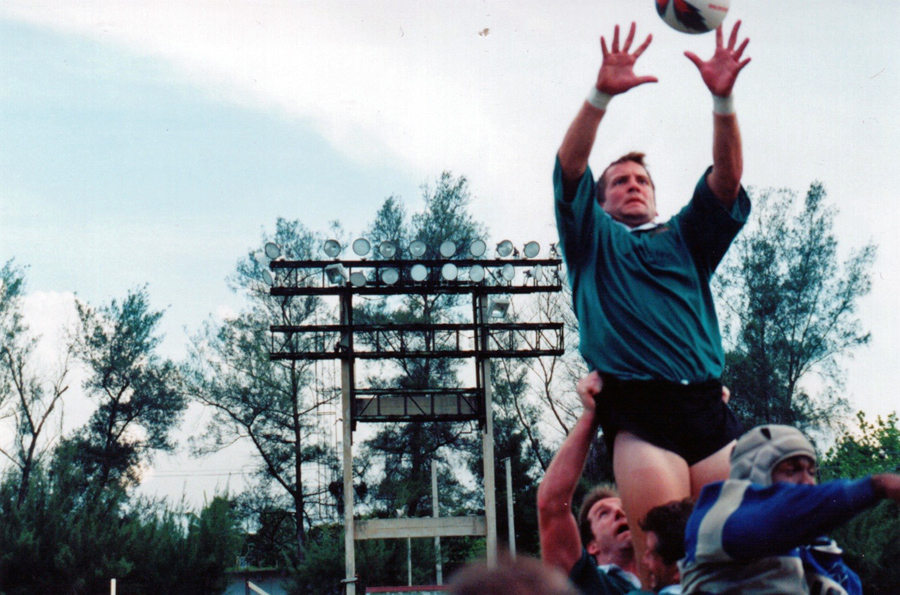
Steve Robke, lifted by Tom Brewer, takes lineout
The players walked through the Cuban line and
presented them with our jerseys. What had seemed
awkward handshakes earlier in the day were more relaxed and
there were smiles all around.
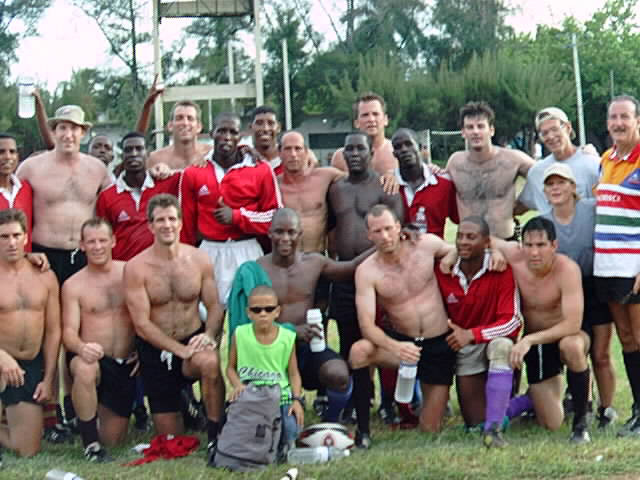
Atlantis and Cuba after this historic game
I thought simply
"We did it!" Not win, but just play . . . the first La
Habana Sevens was a reality!
Limited
Interaction. One purpose of this tour was to interact with
the Cuban people, and we certainly did. Nevertheless,
interaction with the players themselves was far too
limited. Firstly, we never got together Thursday as we had
planned. Secondly, after the tournament we were limited to
sharing a few cases of beer Omar hurriedly bought. After a brief
time everyone dispersed.
One interactive
moment we did have time for was when someone asked the Cubans to
pick the biggest nose on the team, in a run-off between Stephens
and Brewer.
Tom
Brewer -- No rugby tour would be complete without a
few laughs, and this tour was filled with them. One
memorable moment was when Stack was voted Biggest Nose by the
Cubans, thus sharing the title that Billy Russell proudly holds
from the Fijians.
The only
unpleasant incident of the tour took place following the
tournament. We all had zillions of things to give away to
the Cuban rugby players, and as we began to get them out, the
players (and, unfortunately, others) swarmed around us and we
were overwhelmed with people taking stuff as fast as we could
get them out of our bags. In one case, this resulted in a
non-playing hustler getting a pair of cleats. Meanwhile,
most of the national team players that had actually competed
against were still cooling down a few yards away. It
wasn't pretty.
I also heard
later that as our players were giving the jerseys to their
opposites, one player asked if this could be done later, as in
France the jerseys were taken from them (property of the State,
I guess). By that time, though, it was too late.
Curiously, no one remembers seeing any of the players with an
Atlantis jersey after they reached the stands.
Marcel commented
that the best thing was to play the game, have a quick beer and
leave.
But we don't want
to settle for that. We can do better.
14.
Future of la Habana Sevens?
The Cubans want
to make this an annual event. To attract the European
teams they're after, they were speaking about mid to late June
as a better date.
They need far,
far better organization if this tournament is to fly. We
came prepared for a lack of organization, but the people that
ran this tournament struggled to deal with 5 teams, let alone
more. We can help -- and could have helped this year --
but they seemed uninterested.
There's a long,
long way to go, but a huge step has already been taken.
15.
Farewell to Cuba
For Omar, Al and
me, saying good bye to our families was bittersweet: we all
wanted to get home, but we knew how much joy we were giving them
and I think all three of us wouldn't have minded staying a few
more days to spend more time with them.
At the same time
that we brought them joy, I wonder if we also brought them
desperation. Both Al and I have relatives that want to get
out of Cuba so badly . . . while we're they're, they have
hope. But, when we leave? It's hard to know.
I'm also
distressed because, during my visit but before I got to see him,
my 81-year old tío Bebo suffered acute appendicitis accompanied
by serious infection. During the rest of our stay, he
remained in intensive care and as I write he is still in serious
condition. Thank God I saw him last year! Hopefully
I will see him next year as well.
It's been a
wonderful week.
Steve
Robke - This was the most interesting and unique
rugby tour I've ever been on.
Tom Brewer
-- I may be echoing others but Cuba was, arguably, my most
memorable tour.
Warren
Weiss - This was the most unique experience in my
life.
Doc Sue
Bercuk -- Once again I find myself saying how kind
the people are, how stunning the city is, how beautiful the
beaches are, how great the food is, how exciting the music and
the dancing are. The emotion of this tour cannot be
expressed in words.
Al
Caravelli - It saddens me, on the one hand, that
this may be my last -- certainly nearly my last -- tour as a
player. If it is the last, though, what a great way to go
out.
Heide
Signes -- I am somewhat prejudiced but on this tour
Emil outdid himself in putting the team together. All were
terrific, sensitive people who adapted to and enjoyed the
circumstances and people they found in Cuba. I was proud
to be part of the inaugural Havana Sevens tour.
With so many
people calling this the best tour ever, I had to ask myself the
same question. I started thinking about the more than 40
overseas tours I've been on, and . . . I can't think of any to
top it.
Every life
should have at least one experience like this.
Addendum of 2013
July 2013. When
I was looking at photos to include in this article I found
a couple of camellos that we saw in
the street during our visit. Camello
means camel (for its shape) and it was a uniquely Cuban
bus. At the time I first wrote up this tour, there
was so much information overload already that I didn't
include them. Now, however, the camello
is gone, presumably forever. As a product specifically
of this time (for about a dozen years), begun in the
early/mid 90s when the Soviet Union collapsed (and so did
the $6 billion Soviet fuel subsidies), I figured it might
be interesting to include it here. In the mid/late-2000s,
after receiving heavily subsidized fuel from Venezuela and
new buses from China, Cuba was able to stop the use of the
camello.
Camellos could fit perhaps as many as 400
people; I remember my cousin Roxana telling me about being
groped - often - while riding in a camello
and not being able do anything about it.
The first picture below shows not only a camello
in all its glory, but also a biker. Bikes were
virtually nonexistent on the streets of Havana in
pre-Castro Cuba; as poverty increased with the demise of
the Soviet Union & its aid, however, bikes became
ubiquitous. The second picture shows 3 generations
of vehicles typical of 2000 Havana: a 1950s American car
(a Buick), behind it a 1970s Soviet car, and, curbside, a
camello.
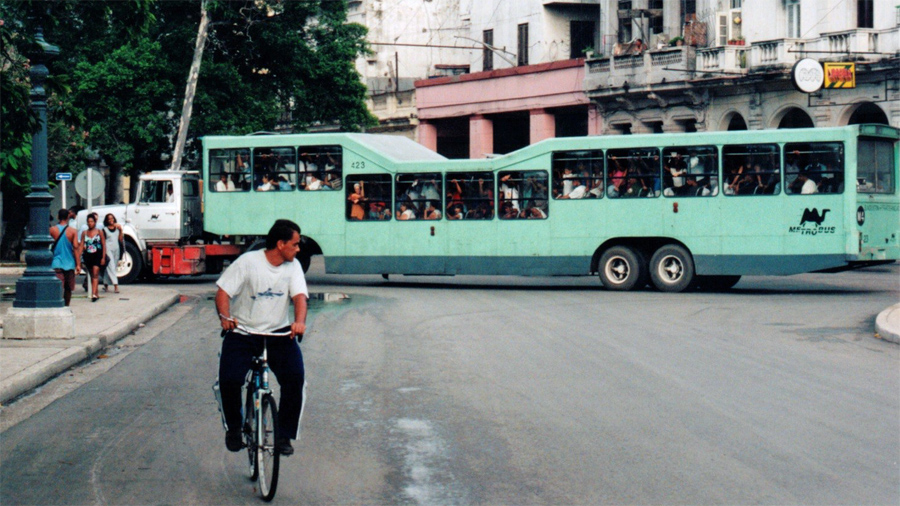
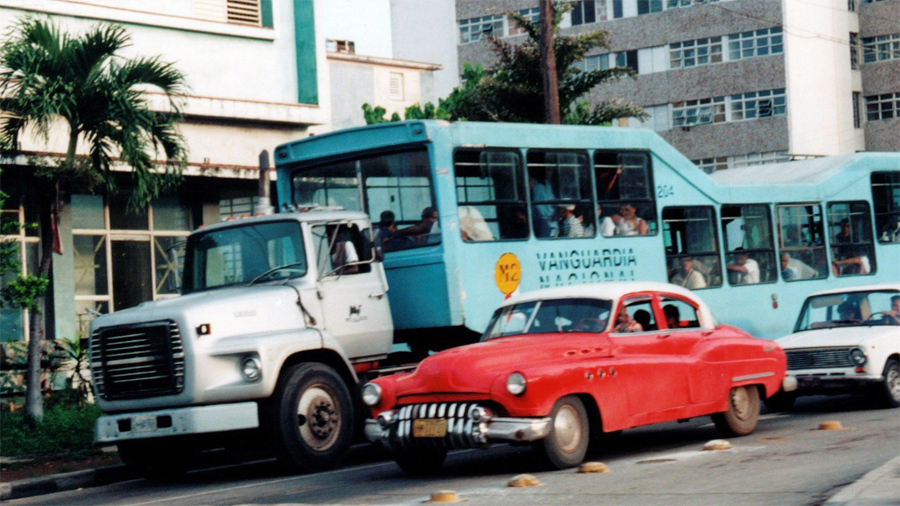 Left: Camello and a bike in downtown
Havana
Left: Camello and a bike in downtown
Havana
Right: a
red early 50s Buick, behind it a 70s Soviet car, and a camello

















